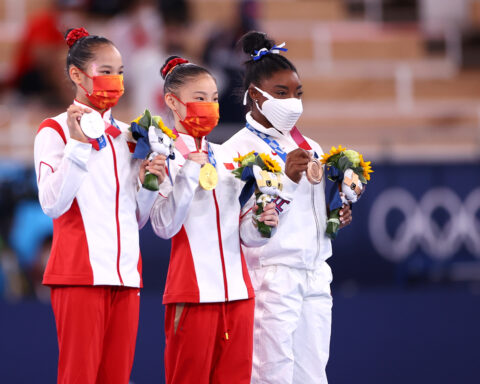By WILL GRAVES
Grambling State University is in the exploratory process of becoming the first historically Black college and university to offer women’s gymnastics.
“Our university leadership is looking at young gymnasts in our community and realizing and understanding the path from toddler gymnastics tumbling to the Olympics for a Black and brown gymnast is arduous,” said Raven Thissel, the marketing and public relations director for The Doug Williams Center, located on Grambling’s campus. “How can we make it a smoother one?”
Grambling hosted 100 Black and brown gymnasts over the weekend for the Brown Girls Do Gymnastics annual conference. Derrin Moore founded the organization in 2015. The foundation is dedicated to providing “scholarships, coaching, training and other forms of support to athletes from underrepresented and marginalized groups.”
The conference isn’t just focused on athletic development. There are also workshops planned for parents to educate them on what it takes to rise if their athletes want to graduate from entry-level programs to the NCAA/elite level. It’s an element that Moore believes can get lost for members of the Black community.
“It’s just giving families a little edge,” Moore said. “We want to give them information so they can step into the gymnastics arena and be confident and advocating for their girls.”
The face of gymnastics in the United States is changing. There are more athletes of color starting — and sticking — in a sport long dominated by white athletes at the highest levels.
Half of the U.S. women’s Olympic delegation walked onto the floor — Simone Biles, Jordan Chiles and Sunisa Lee — at Ariake Gymnastics Center for Olympic qualifying on Sunday are minorities. Biles and Chiles are African American; Lee is Hmong American.
More than half of the 18 women invited to Olympic trials in St. Louis last month were women of color. While numbers are still low on college teams, there is progress. Black women account for nearly 10% of the scholarship athletes at the NCAA Division I level, an increase from 7% in 2012. More than 10% of USA Gymnastics membership self-identify as Black.
And while the current athletes at the top level of the sport were already involved when Gabby Douglas became the first Black woman to win the Olympic all-around title in London in 2012, the rise in participation among athletes of color since Douglas’ golden moment is real, one amplified by Biles’ unmatched brilliance.
“Simone has opened the eyes to so many women of color saying ’Hey, you can do this, too,'” said Cecile Landi, who has served as Biles’ co-coach along with husband Laurent since the fall of 2017. “It’s not just little skinny white girls that can do it. Anyone can do it. And then it’s a Black-owned business, so I think it attracts its own families that way.”
There’s a phenomenon that happens every time Biles appears on a screen inside Power Moves Gymnastics & Fitness.
As if flipping a switch, the young women of color on the gym’s competitive team spring to life, fueled by the jolt of adrenaline that comes with watching the reigning Olympic champion test the limits of their sport.
“They just get this motivation that’s just unreal,” said DeLissa Walker, who co-owns the gym just outside New York City with her sister Candice. “And we’re like, ‘Wow, they’re really inspired.’ … They’re like ‘This can be me.’”
The Walkers, both board members at Brown Girls Do Gymnastics, already are starting to see the results of the foundation’s efforts. The business they started in 2012 in a space so small it’s now a barbershop is thriving. They moved to a warehouse in 2015 before opening at their current location in Cedarhurst, New York — on Long Island, about 20 miles from Manhattan — last August.
Even as they’ve grown, the majority of their clientele has remained athletes of color. Eight members of Power Moves competitive team were at Grambling over the weekend to participate in the Isla Invitational, an exhibition held in conjunction with the conference. The Walkers view it as the next step in the growth process for girls — and their families —eyeing a long-term commitment.
It’s a commitment that requires a significant investment of both time and money. Some members of the competitive team put in five to six hours a day several times a week. The Walkers estimate their monthly dues are about half of what other gyms in the area charge. They offer discounts for siblings and promote fundraisers.
Moore’s gym limits the number of competition leotards her athletes use and believes her coaches are willing to work for less because they view their mission as more of a calling than a job.
They are preparing for another spike in interest among Black communities that is likely in the offing as Biles steps onto the world stage again. The Walkers, both former competitive gymnasts, are encouraged by what they see, but work remains to be done.
Biles has vowed to remain in the sport long after the Olympic flame in Tokyo is passed along to organizers for the 2024 Games in Paris. Three years from now, perhaps some of the young Black girls who entered the sport in the afterglow of Douglas’ victory in London will be the ones in the mix to represent the United States in France or scattered across NCAA gymnastics programs across the country, maybe even at historically Black colleges and universities like Grambling.
“Representation does matter,” Gina Chiles said. “And Simone has put her foot in it. She’s definitely set that path in a lot of ways. Whatever level you go to, you can be excellent at that level. And a lot of Black girls see that. And a lot of Black girls now want to be that.”







